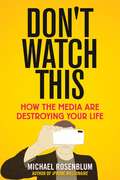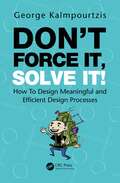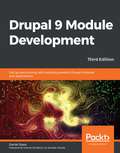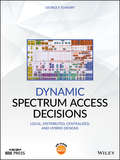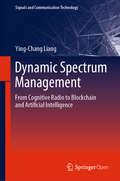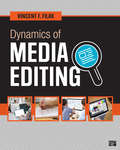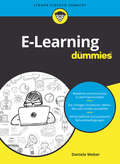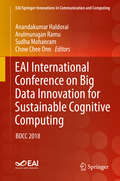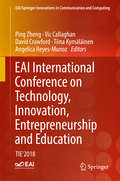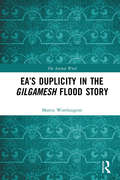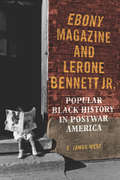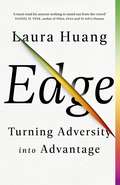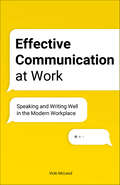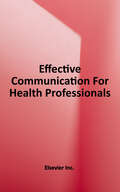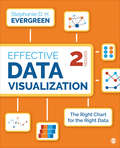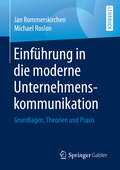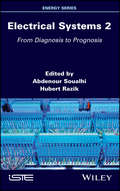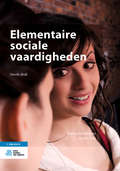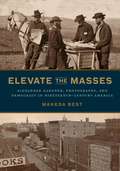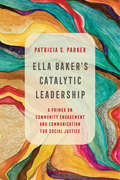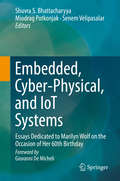- Table View
- List View
Don't Watch This: How the Media Are Destroying Your Life
by Michael RosenblumAn unfiltered look at the addictive properties of social media, TV, and movies on our culture, with strategies to help you reclaim control over your life. Today, the average person spends an astonishing eight hours a day watching TV or videos online. Watching social media stories, movies, and TV is now our number one activity, outpacing everything else that we do, including sleep. This habit has an incredibly powerful influence on our lives – from what we think to what we buy to whom we elect. Media are more than entertainment; they are a drug. This media addiction wreaks havoc on our mental health, causing increased stress, depression, and anxiety, and ruining personal relationships. It also drives us deeper and deeper into debt. In Don&’t Watch This, former TV producer and Ivy League professor Michael Rosenblum reveals the hidden psychology driving us to media addiction. He describes why solving the problem is not as simple as swearing off our devices, but about learning how to use media for good. Rosenblum reveals the key to getting the best out of technology, without letting it get the best of you. Inside, you&’ll learn: How to take control of the mediaHow to use your phone&’s camera to spread stories worth tellingHow having a former reality TV star in the Oval Office has changed the scope of mediaWhy posting selfies on Instagram isn&’t going to change the world, and what you can post instead Enlightening and empowering, Don&’t Watch This provides actionable, revolutionary techniques and insight to control your media addiction—helping you live the life you really want.
Don’t Force It, Solve It!: How To Design Meaningful and Efficient Design Processes
by George Kalmpourtzis"Knowing various frameworks and methodologies is crucial.… This book takes you one step further by transforming individuals or teams into adaptable problem-solving powerhouses." George Ketsiakidis, Design Researcher, Shanghai Jiao Tong University "George is a master of design process thinking, and it comes out in every word of his writing." Ryan Gerber, Founder, Quest Labs It’s not how much time we spend on design that impacts product and service success: it’s whether that time has been spent on solving the right problems. The field of design, with a greater focus on user-centered design, steadily acquires a central position on the work of product design teams. From large corporate environments to startups, multidisciplinary teams of developers, designers, project managers, and product managers need to find ways to understand each other’s needs, overcome obstacles, communicate efficiently, and perform, creating products that satisfy their users’ needs. In an era when the main differentiating factor between products are the teams that created them, George Kalmpourtzis’ Don’t Force It, Solve It!: How To Design Meaningful and Efficient Design Processes is the perfect roadmap for navigating the twisting paths of project management and user-centered design. KEY FEATURES: • This book aims at helping software teams work more efficiently by setting up their own design processes. • For organizations, this book helps decode the design processes, allowing them to deliver experiences that address the real problems of their audiences. • This book offers a combination of theory and practice that will help its readers understand how to design efficient processes and apply this knowledge in their own work. • This book includes many insights in the form of colorful doodles. George Kalmpourtzis is an award-winning User Experience & Learning Experience Consultant and Game Designer. Finding himself between the fields of educational technology, design, and game studies, he has been founder, C-level stakeholder, director, and board member of several design studios, startups, and consulting agencies.
Drupal 9 Module Development: Get up and running with building powerful Drupal modules and applications, 3rd Edition
by Daniel Sipos Antonio De MarcoBuild and extend flexible Drupal sites and applications with this up-to-date, expert guide to Drupal 9 module development Key Features Explore the essential Drupal 9 APIs for module development Learn how to implement data modeling, caching, architecture, and much more in your Drupal applications Discover what's new in the latest Drupal core releases Book Description With its latest release, Drupal 9, the popular open source CMS platform has been updated with new functionalities for building complex Drupal apps with ease. This third edition of the Drupal Module Development guide covers these new Drupal features, helping you to stay on top of code deprecations and the changing architecture with every release. The book starts by introducing you to the Drupal 9 architecture and its subsystems before showing you how to create your first module with basic functionality. You'll explore the Drupal logging and mailing systems, learn how to output data using the theme layer, and work with menus and links programmatically. Once you've understood the different kinds of data storage, this Drupal guide will demonstrate how to create custom entities and field types and leverage the Database API for lower-level database queries. You'll also learn how to introduce JavaScript into your module, work with various file systems, and ensure that your code works on multilingual sites. Finally, you'll work with Views, create automated tests for your functionality, and write secure code. By the end of the book, you'll have learned how to develop custom modules that can provide solutions to complex business problems, and who knows, maybe you'll even contribute to the Drupal community! What you will learn Develop custom Drupal 9 modules for your applications Master different Drupal 9 subsystems and APIs Model, store, manipulate, and process data for effective data management Display data and content in a clean and secure way using the theme system Test your business logic to prevent regression Stay ahead of the curve and write PHP code by implementing best practices Who this book is for If you are a Drupal developer looking to learn Drupal 9 to write modules for your sites, this book is for you. Drupal site builders and PHP developers with basic object-oriented programming skills will also find this book helpful. Although not necessary, some Symfony experience will help with understanding concepts easily.
Dynamic Spectrum Access Decisions: Local, Distributed, Centralized, and Hybrid Designs (Wiley - IEEE)
by George F. ElmasryOptimize your dynamic spectrum access approach using the latest applications and techniques Dynamic Spectrum Access Decisions: Local, Distributed, Centralized and Hybrid Designs prepares engineers to build optimum communications systems by describing at the outset what type of spectrum sensing capabilities are needed. Meant for anyone who has a basic understanding of wireless communications and networks and an interest in the physical and MAC layers of communication systems, this book has a tremendous range of civilian and military applications. Dynamic Spectrum Access Decisions provides fulsome discussions of cognitive radios and networks, but also DSA technologies that operate outside the context of cognitive radios. DSA has applications in: · Licensed spectrum bands · Unlicensed spectrum bands · Civilian communications · Military communications Consisting of a set of techniques derived from network information theory and game theory, DSA improves the performance of communications networks. This book addresses advanced topics in this area and assumes basic knowledge of wireless communications.
Dynamic Spectrum Management: From Cognitive Radio to Blockchain and Artificial Intelligence (Signals and Communication Technology)
by Ying-Chang LiangThis open access book, authored by a world-leading researcher in this field, describes fundamentals of dynamic spectrum management, provides a systematic overview on the enabling technologies covering cognitive radio, blockchain, and artificial intelligence, and offers valuable guidance for designing advanced wireless communications systems. This book is intended for a broad range of readers, including students and professionals in this field, as well as radio spectrum policy makers.
Dynamics of Media Editing
by Vincent F. FilakAs traditional newsrooms staffed by journalists and managed by experienced editors become less and less common, there is an even greater need for all types of professional writers to be fluent in the editorial process. Dynamics of Media Editing emphasizes the broad value of editing as both a tool for journalistic management and an essential skill for individual writers of all stripes. Author Vince F. Filak recognizes editing as an essential process for improving the quality of published writing, something that is relevant and essential to investigative journalists, social media interns, celebrity bloggers, and everyone in between. By organizing the book around skills and by platforms, Dynamics of Media Editing shows students how the basic principles of good editing work across disciplines and media platforms. Key Features The emphasis on transferrable skills and multiple platforms shows students how to use the basic principles of good editing for journalism, PR, advertising, or social media marketing. The book takes a broad approach to editing, demonstrating that it’s not just a skill for managers at newspapers, but rather an essential process for improving all aspects of published writing. This addresses a critical course challenge, in that many students don’t see the relevance of editing in their planned careers. The audience-centric method emphasizes the need to engage one’s audience in order to be a successful writer. "Helpful Hints" boxes provide easy-to-consult lists of dos and don’ts for good writing. "Thoughts From a Pro" boxes allow media professionals from a variety of backgrounds to demonstrate the essential function of the editing process in the workplace.
Dynamics of Media Editing
by Vincent F. FilakAs traditional newsrooms staffed by journalists and managed by experienced editors become less and less common, there is an even greater need for all types of professional writers to be fluent in the editorial process. Dynamics of Media Editing emphasizes the broad value of editing as both a tool for journalistic management and an essential skill for individual writers of all stripes. Author Vince F. Filak recognizes editing as an essential process for improving the quality of published writing, something that is relevant and essential to investigative journalists, social media interns, celebrity bloggers, and everyone in between. By organizing the book around skills and by platforms, Dynamics of Media Editing shows students how the basic principles of good editing work across disciplines and media platforms. Key Features The emphasis on transferrable skills and multiple platforms shows students how to use the basic principles of good editing for journalism, PR, advertising, or social media marketing. The book takes a broad approach to editing, demonstrating that it’s not just a skill for managers at newspapers, but rather an essential process for improving all aspects of published writing. This addresses a critical course challenge, in that many students don’t see the relevance of editing in their planned careers. The audience-centric method emphasizes the need to engage one’s audience in order to be a successful writer. "Helpful Hints" boxes provide easy-to-consult lists of dos and don’ts for good writing. "Thoughts From a Pro" boxes allow media professionals from a variety of backgrounds to demonstrate the essential function of the editing process in the workplace.
E-Learning für Dummies (Für Dummies)
by Daniela WeberEgal, ob beim Unterrichten an der Uni, bei Weiterbildungen im Job oder bei der Arbeit von Trainern, ohne Lerninhalte im Internet ist dies kaum mehr vorstellbar. Erfahren Sie wie Sie Ihr Online-Angebot richtig erstellen. Daniela Weber erklärt Ihnen die Grundlagen des E-Learning und gibt Ihnen das richtige Handwerkszeug mit, um bewährte und innovative E-Learning-Konzepte erfolgreich und im Budget umzusetzen. Dabei erfahren Sie alles Wichtige von der Wahl der geeigneten Instrumente und Inhalte bis hin zur Implementierung Ihres E-Learning-Angebots. So gelingt Ihr Start in der Online-Lehre.
EAI International Conference on Big Data Innovation for Sustainable Cognitive Computing: BDCC 2018 (EAI/Springer Innovations in Communication and Computing)
by Chow Chee Onn Anandakumar Haldorai Arulmurugan Ramu Sudha MohanramThis proceeding features papers discussing big data innovation for sustainable cognitive computing. The papers feature detail on cognitive computing and its self-learning systems that use data mining, pattern recognition and natural language processing (NLP) to mirror the way the human brain works. This international conference focuses on cognitive computing technologies, from knowledge representation techniques and natural language processing algorithms to dynamic learning approaches. Topics covered include Data Science for Cognitive Analysis, Real-Time Ubiquitous Data Science, Platform for Privacy Preserving Data Science, and Internet-Based Cognitive Platform. The EAI International Conference on Big Data Innovation for Sustainable Cognitive Computing (BDCC 2018), took place on 13 – 15 December 2018 in Coimbatore, India.
EAI International Conference on Technology, Innovation, Entrepreneurship and Education: TIE'2018 (Lecture Notes in Electrical Engineering #532)
by David Crawford Angelica Reyes-Munoz Ping Zheng Vic Callaghan Tiina KymäläinenThis book presents the proceedings of the 2nd EAI International Conference on Technology, Innovation, Entrepreneurship and Education (TIE' 2018), which took place at Ravensbourne University London, London, UK, on September 4, 2018. The central theme of the conference is emerging technologies in relation to business, education, social and political needs that make modern society flourish. The proceedings feature papers from a cross-disciplinary audience that explore the process of creativity and innovation. The goal is that the various disciplines can learn from each other and see how they might benefit from the cross-fertilization of practices.
Ea’s Duplicity in the Gilgamesh Flood Story (The Ancient Word)
by Martin WorthingtonThis volume opens up new perspectives on Babylonian and Assyrian literature, through the lens of a pivotal passage in the Gilgamesh Flood story. It shows how, using a nine-line message where not all was as it seemed, the god Ea inveigled humans into building the Ark. The volume argues that Ea used a ‘bitextual’ message: one which can be understood in different ways that sound the same. His message thus emerges as an ambivalent oracle in the tradition of ‘folktale prophecy’. The argument is supported by interlocking investigations of lexicography, divination, diet, figurines, social history, and religion. There are also extended discussions of Babylonian word play and ancient literary interpretation. Besides arguing for Ea’s duplicity, the book explores its implications – for narrative sophistication in Gilgamesh, for audiences and performance of the poem, and for the relation of the Gilgamesh Flood story to the versions in Atra-hasīs, the Hellenistic historian Berossos, and the Biblical Book of Genesis. Ea’s Duplicity in the Gilgamesh Flood Story will interest Assyriologists, Hebrew Bible scholars and Classicists, but also students and researchers in all areas concerned with Gilgamesh, word-play, oracles, and traditions about the Flood.
Ebony Magazine and Lerone Bennett Jr.: Popular Black History in Postwar America
by E. James WestFrom its launch in 1945, Ebony magazine was politically and socially influential. However, the magazine also played an important role in educating millions of African Americans about their past. Guided by the pen of Lerone Bennett Jr., the magazine’s senior editor and in-house historian, Ebony became a key voice in the popular black history revival that flourished after World War II. Its content helped push representations of the African American past from the margins to the center of the nation’s cultural and political imagination. E. James West's fresh and fascinating exploration of Ebony’s political, social, and historical content illuminates the intellectual role of the iconic magazine and its contribution to African American scholarship. He also uncovers a paradox. Though Ebony provided Bennett with space to promote a militant reading of black history and protest, the magazine’s status as a consumer publication helped to mediate its representation of African American identity in both past and present. Mixing biography, cultural history, and popular memory, West restores Ebony and Bennett to their rightful place in African American intellectual, commercial, and political history.
Eco-Translatology: Towards an Eco-paradigm of Translation Studies (New Frontiers in Translation Studies)
by (Hugs) Gengshen HuThis book offers a panoramic view of the emerging eco-paradigm of Translation Studies, known as Eco-Translatology, and presents a systematic study of the theoretical discourse from ecological perspectives in the field of Translation Studies. Eco-Translatology describes and interprets translation activities in terms of the ecological principles of Eco-holism, traditional Eastern eco-wisdom, and ‘Translation as Adaptation and Selection’. Further, Eco-Translatology approaches the phenomenon of translation as a broadly conceived eco-system in which the ideas of ‘Translation as Adaptation and Selection’, as well as translation as a ‘textual transplant’ promoting an ‘eco-balance’, are integrated into an all-encompassing vision. Lastly, Eco-Translatology reinforces contextual uniqueness, emphasizing the deep embeddedness of texts, translations, and the human agents involved in their production and reception in their own habitus. It is particularly encouraging, in this increasingly globalised world, to see a new paradigm sourced from East Asian traditions but with universal appeal and applications, and which adds to the diversity and plurality of global Translation Studies. This book, the first of its kind, will substantially expand the horizons of Translation Studies, a field that is still trying to define its own borders, and will open a wealth of new possibilities. Destined to become a milestone in the field of Translation, Interpretation and Adaptation Studies, as well as eco-criticism, it will introduce readers to a wholly new epistemological intervention in Translation Studies and therefore will open new vistas of thoughts, discussion and criticism.
Edge: Turning Adversity into Advantage
by Laura HuangSHORTLISTED FOR THE BUSINESS BOOK AWARDS 2021How do you find a competitive edge when you feel like the world is against you? How do you get people to take you seriously when they're predisposed not to?Star Harvard Business School professor Laura Huang has come up against that problem many times - and so has anyone who's ever felt out of place or underrecognised. Many of us sit back quietly, hoping that our hard work and grit will speak for themselves. Or we force ourselves to fit the mold of what we perceive as 'successful', stifling the creativity and charm that makes us memorable.In this perfect guide for ambitious readers of Amy Cuddy's Presence and Angela Duckworth's Grit looking for the missing piece that will take them to the next level, Huang offers a different approach.She argues that success is rarely about the quality of your ideas, your credentials and skills or the effort you put in. Instead, it's about how well you shape others' perceptions - about your strengths, yes, but also about your flaws. It's about creating an edge by confronting the factors that seem like shortcomings and turning them into assets that persuade others to take notice.Drawing from her research on gut feeling, pitching and investment decisions, as well as stories about previously overlooked Olympians, assistants-turned executives and first-time entrepreneurs, Huang shows that success comes from knowing who you are and using that knowledge unapologetically and strategically. This book will teach you how to find your unique edge and keep it sharp.
Effective Communication at Work: Speaking and Writing Well in the Modern Workplace
by Vicki McLeodDevelop effective communication skills for the office—in-person and onlineIn the digital age, as workers increasingly go remote, the ability to communicate clearly and effectively is—now more than ever—a highly desirable skill. Whether you talk, text, or email, Effective Communication at Work has everything you need to help boost your workplace performance and productivity.From honing listening to polishing speaking and writing skills, this essential guide delivers simple, powerful strategies and timely tips that can help you increase the impact of your business communication and correspondence both online and offline. Learn how to build stronger relationships and advance your career by mastering the art of effective communication.Effective Communication at Work includes:Expert advice—Get the latest tips for working and communicating in the digital world.Clarity is king—Discover a variety of effective communication styles and formats, including writing and speaking, with simplicity and accuracy.Cultivating relationships—Learn best practices for becoming a better human while working with others in an office environment, including mindfulness, empathy, diversity, and self-awareness.Gain a competitive edge by harnessing the power of effective communication.
Effective Communication for Health Professionals
by Elsevier IncEnsure you have the skills to effectively communicate with patients and other healthcare professionals! With its easy-to-read style, Effective Communication for Health Professionals, 2nd edition, is loaded with useful tips and exercises to help you learn the universal (and necessary) practice of communication. This full-color second edition reflects current therapeutic techniques, including Communication Guidelines feature boxes, Words at Work dialogue boxes, added case studies, and all-new content exploring the most current communication tools in the modern health care setting. In addition, interactive exercises on the Evolve companion website encourages you to practice therapeutic communication techniques in real-life situations. - UNIQUE! Interactive activities on accompanying Evolve site include a variety of application exercises such as scenarios with voice mail messages and patient/caregiver interviews. - Easy-to-read style provides practical information, hints, and tips. - Test Your Communication IQ boxes provide you with a short self-assessment test at the beginning of each chapter. - Spotlight on Success boxes provide you with useful, practical tips for improving workplace habits and communication. - Expanding Critical Thinking boxes provide actual case examples and activities with useful tips to help you apply what you've learned to practice. - Legal Eagle boxes provide useful tips that focus on honesty, as well as ethical and legal communication between patients and healthcare workers. - End-of-chapter questions and exercises help you to use knowledge learned from topics presented in the chapter. - NEW! Chapter devoted to cross-cultural communication promotes understanding of care in a diverse workplace - NEW! Chapter on diseases and disorders discusses communication with patients experiencing specific physical and mental illnesses and disorders. - NEW and UNIQUE! Words at Work dialogue boxes demonstrate actual conversations between healthcare workers and clients. - UPDATED! Content reflects the most current communication tools for the modern healthcare setting. - NEW! Full-color design and art program promote engagement. - NEW and UNIQUE! Communication Guidelines boxes direct you to best practices for the effective exchange of information. - NEW! Additional Taking the Chapter to Work case studies demonstrate real-life communication pitfalls and successes.
Effective Data Visualization: The Right Chart for the Right Data
by Stephanie EvergreenNOW IN FULL COLOR! Written by sought-after speaker, designer, and researcher Stephanie D. H. Evergreen, Effective Data Visualization shows readers how to create Excel charts and graphs that best communicate their data findings. This comprehensive how-to guide functions as a set of blueprints—supported by both research and the author’s extensive experience with clients in industries all over the world—for conveying data in an impactful way. Delivered in Evergreen’s humorous and approachable style, the book covers the spectrum of graph types available beyond the default options, how to determine which one most appropriately fits specific data stories, and easy steps for building the chosen graph in Excel. Now in full color with new examples throughout, the Second Edition includes a revamped chapter on qualitative data, nine new quantitative graph types, new shortcuts in Excel, and an entirely new chapter on Sharing Your Data With the World, which provides advice on using dashboards. New from Stephanie Evergreen! The Data Visualization Sketchbook provides advice on getting started with sketching and offers tips, guidance, and completed sample sketches for a number of reporting formats. Bundle Effective Data Visualization, 2e, and The Data Visualization Sketchbook, using ISBN 978-1-5443-7178-8!
Effective Data Visualization: The Right Chart for the Right Data
by Stephanie EvergreenNOW IN FULL COLOR! Written by sought-after speaker, designer, and researcher Stephanie D. H. Evergreen, Effective Data Visualization shows readers how to create Excel charts and graphs that best communicate their data findings. This comprehensive how-to guide functions as a set of blueprints—supported by both research and the author’s extensive experience with clients in industries all over the world—for conveying data in an impactful way. Delivered in Evergreen’s humorous and approachable style, the book covers the spectrum of graph types available beyond the default options, how to determine which one most appropriately fits specific data stories, and easy steps for building the chosen graph in Excel. Now in full color with new examples throughout, the Second Edition includes a revamped chapter on qualitative data, nine new quantitative graph types, new shortcuts in Excel, and an entirely new chapter on Sharing Your Data With the World, which provides advice on using dashboards. New from Stephanie Evergreen! The Data Visualization Sketchbook provides advice on getting started with sketching and offers tips, guidance, and completed sample sketches for a number of reporting formats. Bundle Effective Data Visualization, 2e, and The Data Visualization Sketchbook, using ISBN 978-1-5443-7178-8!
Einführung in die moderne Unternehmenskommunikation: Grundlagen, Theorien und Praxis
by Jan Rommerskirchen Michael RoslonDieses Buch bietet eine verständliche und aktuelle Einführung in die vielfältigen Teilbereiche der Kommunikation von Unternehmen. Es hilft Studierenden und Praktikern, die komplexen Zusammenhänge zwischen der Kommunikation von Unternehmen und den Erwartungen ihrer Anspruchsgruppen zu verstehen. In den letzten Jahren haben sich diese Erwartungen verändert und die öffentlichen Forderungen nach mehr Nachhaltigkeit im Umgang mit Ressourcen, mehr Gerechtigkeit gegenüber Mitarbeitern und mehr Haltung zu gesellschaftspolitischen Themen bringen die Unternehmen in Zugzwang. Die moderne Unternehmenskommunikation muss nicht zuletzt die soziale Rolle des Unternehmens in der Weltgesellschaft definieren und positionieren. Ihre Aufgaben gehen damit weit über die klassischen Bereiche Marktkommunikation, interne Kommunikation und Public Relations hinaus. Dieses Buch erläutert die Grundlagen und die Praxis der modernen Unternehmenskommunikation in den wichtigsten Teilbereichen und erklärt, wie sie die Herausforderungen der aktuellen Veränderungen bewältigen kann.
Electrical Systems 2: From Diagnosis to Prognosis
by Hubert Razik Abdenour SoualhiMethods of diagnosis and prognosis play a key role in the reliability and safety of industrial systems. Failure diagnosis requires the use of suitable sensors, which provide signals that are processed to monitor features (health indicators) for defects. These features are required to distinguish between operating states, in order to inform the operator of the severity level, or even the type, of a failure. Prognosis is defined as the estimation of a system's lifespan, including how long remains and how long has passed. It also encompasses the prediction of impending failures. This is a challenge that many researchers are currently trying to address. Electrical Systems, a book in two volumes, informs readers of the theoretical solutions to this problem, and the results obtained in several laboratories in France, Spain and further afield. To this end, many researchers from the scientific community have contributed to this book to share their research results.
Elementaire sociale vaardigheden: Transferpunt Vaardigheidsonderwijs
by Marian Adriaansen Josien CarisDit boek helpt studenten in zorg en welzijn om communicatieve basisvaardigheden zó aan te leren dat die een solide basis vormen voor de ontwikkeling van specifieke beroepsvaardigheden. Ook leren ze om die communicatieve vaardigheden in verschillende hulpverleningssituaties toe te passen. Daarbij heeft het boek aandacht voor aan te leren technieken, én voor de echtheid van iemands optreden. Effectief communiceren vereist immers ook kennis over je eigen kwaliteiten. Elementaire sociale vaardigheden gaat uitgebreid in op de theorie, én is erg praktijkgericht. Het s een verdiepend boek, dat studenten handvatten geeft om theorie te oefenen en toe te passen. Aan deze geheel herziene druk is bovendien een nieuw hoofdstuk toegevoegd: omgaan met laaggeletterdheid. Ook nieuw is de mogelijkheid om met behulp van een app direct vanuit het boek de bijpassende filmfragmenten te bekijken. In deze filmfragmenten worden de besproken vaardigheden gedemonstreerd. Ze staan ook op mijn.bsl.nl - net als de toetsvragen, studieopdrachten en oefeningen. Zo kun je eenvoudig kennismaken met de beoogde vaardigheden, en ze actief oefenen.
Elevate the Masses: Alexander Gardner, Photography, and Democracy in Nineteenth-Century America
by Makeda BestAlexander Gardner is best known for his innovative photographic history of the Civil War. What is less known is the extent to which he was involved in the international workers’ rights movement. Tying Gardner’s photographic storytelling to his transatlantic reform activities, this book expands our understanding of Gardner’s career and the work of his studio in Washington, DC, by situating his photographic production within the era’s discourse on social and political reform.Drawing on previously unknown primary sources and original close readings, Makeda Best reveals how Gardner’s activism in Scotland and photography in the United States shared an ideological foundation. She reads his Photographic Sketch Book of the War as a politically motivated project, rooted in Gardner’s Chartist and Owenite beliefs, and illuminates how its treatment of slavery is primarily concerned with the harm that the institution posed to the United States’ reputation as a model democracy. Best shows how, in his portraiture, Gardner celebrated Northern labor communities and elevated white immigrant workers, despite the industrialization that degraded them. She concludes with a discussion of Gardner’s promotion of an American national infrastructure in which photographers and photography played an integral role.Original and compelling, this reconsideration of Gardner’s work expands the contribution of Civil War photography beyond the immediate narrative of the war to comprehend its relation to the vigorous international debates about democracy, industrialization, and the rights of citizens. Scholars working at the intersection of photography, cultural history, and social reform in the nineteenth century on both sides of the Atlantic will find Best’s work invaluable to their own research.
Elevate the Masses: Alexander Gardner, Photography, and Democracy in Nineteenth-Century America
by Makeda BestAlexander Gardner is best known for his innovative photographic history of the Civil War. What is less known is the extent to which he was involved in the international workers’ rights movement. Tying Gardner’s photographic storytelling to his transatlantic reform activities, this book expands our understanding of Gardner’s career and the work of his studio in Washington, DC, by situating his photographic production within the era’s discourse on social and political reform.Drawing on previously unknown primary sources and original close readings, Makeda Best reveals how Gardner’s activism in Scotland and photography in the United States shared an ideological foundation. She reads his Photographic Sketch Book of the War as a politically motivated project, rooted in Gardner’s Chartist and Owenite beliefs, and illuminates how its treatment of slavery is primarily concerned with the harm that the institution posed to the United States’ reputation as a model democracy. Best shows how, in his portraiture, Gardner celebrated Northern labor communities and elevated white immigrant workers, despite the industrialization that degraded them. She concludes with a discussion of Gardner’s promotion of an American national infrastructure in which photographers and photography played an integral role.Original and compelling, this reconsideration of Gardner’s work expands the contribution of Civil War photography beyond the immediate narrative of the war to comprehend its relation to the vigorous international debates about democracy, industrialization, and the rights of citizens. Scholars working at the intersection of photography, cultural history, and social reform in the nineteenth century on both sides of the Atlantic will find Best’s work invaluable to their own research.
Ella Baker's Catalytic Leadership: A Primer on Community Engagement and Communication for Social Justice (Communication for Social Justice Activism #2)
by Patricia S. ParkerElla Baker (1903–1986) was an influential African American civil rights and human rights activist. For five decades, she worked behind the scenes with people in vulnerable communities to catalyze social justice leadership. Her steadfast belief in the power of ordinary people to create change continues to inspire social justice activists around the world. This book describes a case study that translates Ella Baker’s community engagement philosophy into a catalytic leadership praxis, which others can adapt for their work. Catalytic leadership is a concrete set of communication practices for social justice leadership produced in equitable partnership with, instead of on, communities. The case centers the voices of African American teenage girls who were living in a segregated neighborhood of an affluent college town and became part of a small collective of college students, parents, university faculty, and community activists learning leadership in the spirit of Ella Baker.
Embedded, Cyber-Physical, and IoT Systems: Essays Dedicated to Marilyn Wolf on the Occasion of Her 60th Birthday
by Miodrag Potkonjak Senem Velipasalar Shuvra S. BhattacharyyaThis Festschrift is in honor of Marilyn Wolf, on the occasion of her 60th birthday. Prof. Wolf is a renowned researcher and educator in Electrical and Computer Engineering, who has made pioneering contributions in all of the major areas in Embedded, Cyber-Physical, and Internet of Things (IoT) Systems. This book provides a timely collection of contributions that cover important topics related to Smart Cameras, Hardware/Software Co-Design, and Multimedia applications.Embedded systems are everywhere; cyber-physical systems enable monitoring and control of complex physical processes with computers; and IoT technology is of increasing relevance in major application areas, including factory automation, and smart cities. Smart cameras and multimedia technologies introduce novel opportunities and challenges in embedded, cyber-physical and IoT applications. Advanced hardware/software co-design methodologies provide valuable concepts and tools for addressing these challenges.The diverse topics of the chapters in this Festschrift help to reflect the great breadth and depth of Marilyn Wolf's contributions in research and education. The chapters have been written by some of Marilyn’s closest collaborators and colleagues.
